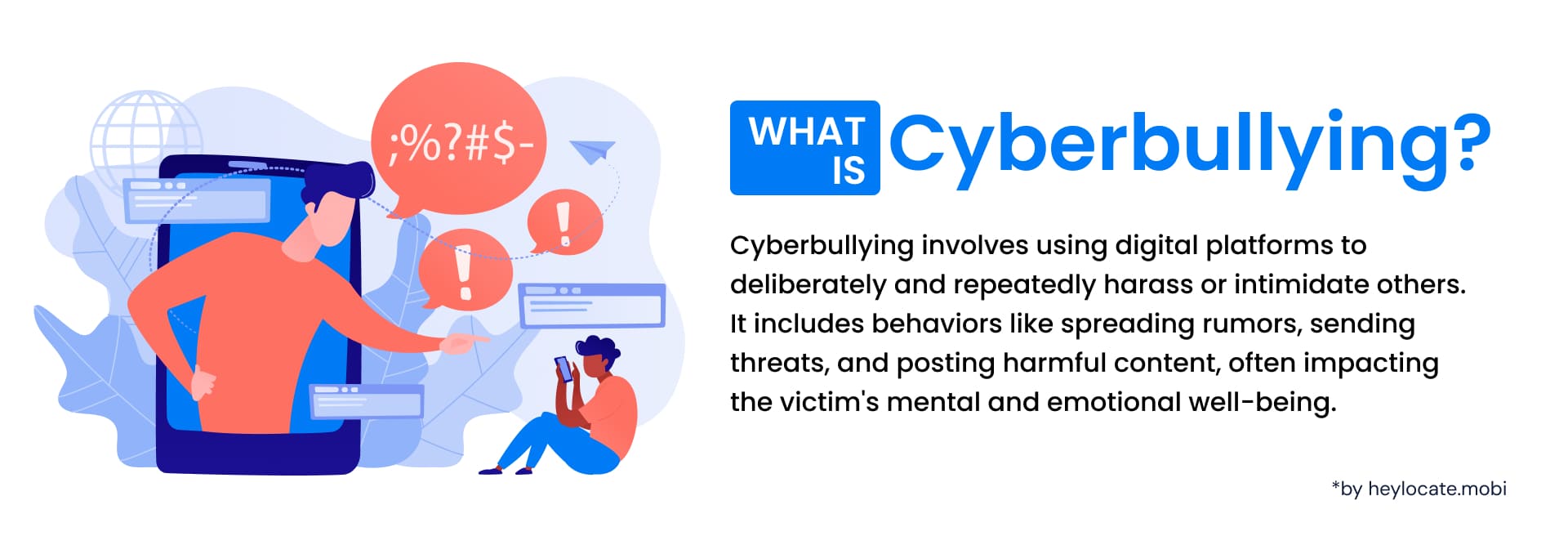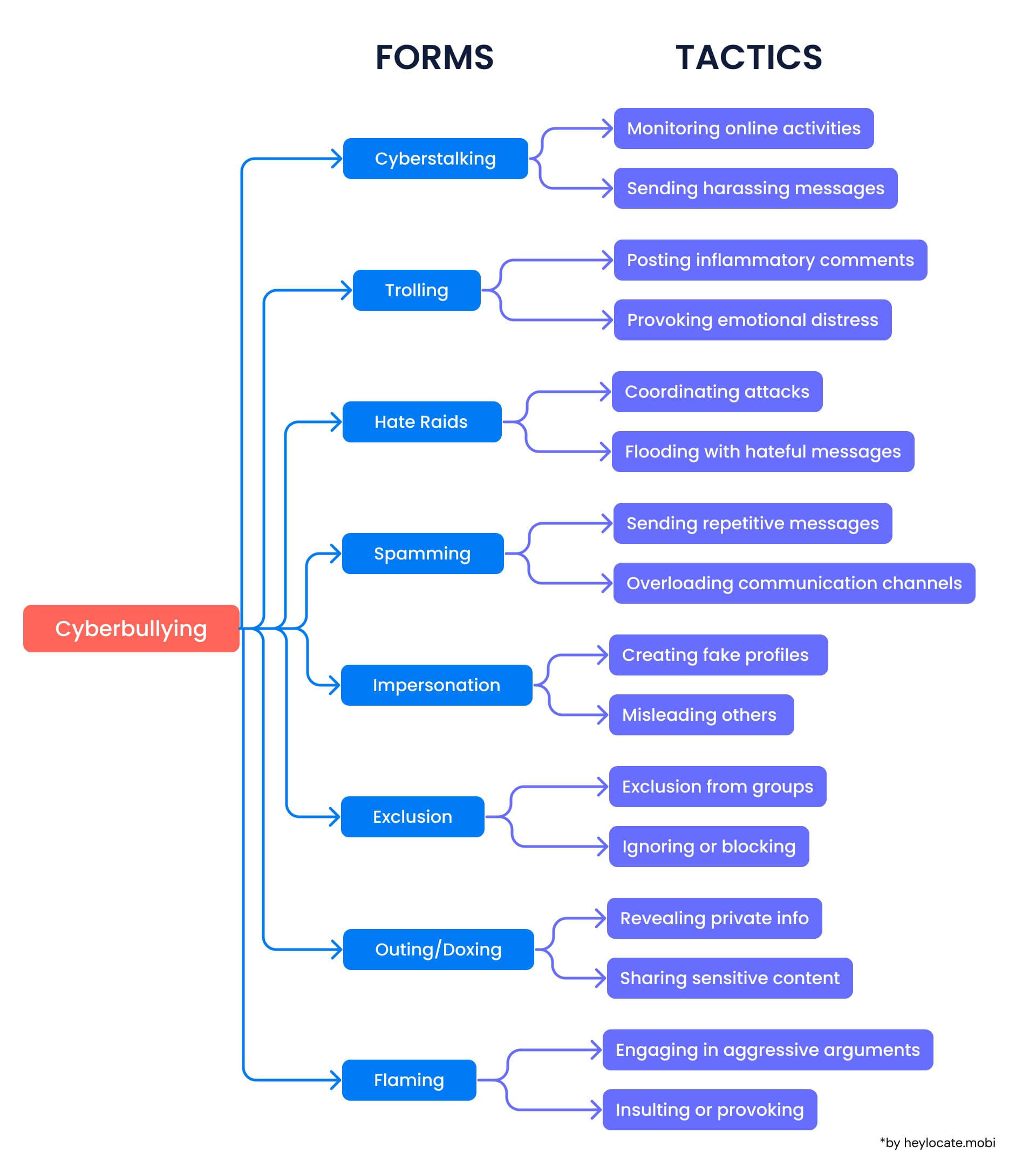Cyberbullying
What is Cyberbullying?
Cyberbullying is the deliberate and repeated use of digital communication tools like social media, instant messaging, or email, to bully, intimidate or defame others. This sort of behavior usually aims at inflicting either emotional pain or damage to the victim, and it may come in different forms, including cyber harassment, online stalking, threatening, or spreading rumors.

Forms and Tactics of Cyberbullying
Cyberbullies use lots of methods to get to their victims. It involves misinformation dissemination, bullying, data exposure without consent, imitation of others, or creation of fake accounts. Main cyberbullying methods include cyberstalking, trolling, raids, spamming, and impersonation.
Cyberstalking refers to ongoing and unnecessary tracking of an individual’s online actions that are conducted with a bad motive. The stalker can collect private data, trace the victim’s steps, and communicate unwantedly. On the other hand, internet trolling refers to purposely inciting people and upsetting them by using offensive and inflammatory remarks. Trolling involves spreading chaos and emotionally destabilizing things by attacking people or particular social media groups.
Hate raids are organized efforts to bombard an individual or group with disgusting or insulting messages through their social media platforms. Spamming means a flood of spam messages with the sole purpose of overwhelming a user with unsolicited and unrelated content. Masquerading can occur by fabricating fake accounts or profiles to deceive and manipulate others, ultimately affecting the victim’s reputation or relationships.

The Nature and Dynamics of Cyberbullying
Cyberbullying extends traditional bullying to the digital world, making it more pervasive and inescapable. It often stems from or perpetuates offline bullying, with individuals using the internet to target victims beyond physical spaces. Cyberbullying differs from other online conflicts due to its repetitive nature and the power imbalance between the bully and the victim.
One crucial aspect of cyberbullying is its potential overlap with sexual harassment. Online sexual harassment can manifest through unsolicited explicit content, non-consensual sharing of intimate images, or derogatory comments about an individual’s appearance or sexuality. When these behaviors target a specific individual repeatedly, they can be considered a form of cyberbullying.
How to Spot Cyberbullying
Addressing Cyberbullying
Cyberbullying, especially in the United States, has been continuously gaining significant attention. The government, schools, and various groups acknowledged the importance of addressing cyberbullying and aim to safeguard individuals’, particularly minors’, well-being online. The U.S. Senate’s “An Educator’s Guide to Cyberbullying” provides valuable legal definitions and responses regarding cyberbullying.
Here’s a summary table outlining steps to take in case of cyberbullying:
| 1 | Document | Keep evidence of cyberbullying (screenshots, messages) |
| 2 | Don’t Respond | Avoid engaging directly with the bully |
| 3 | Block and Report | Use platform features to block the bully and report the abuse |
| 4 | Seek Support | Talk to someone you trust, like a friend, family member, or counselor |
| 5 | Contact Authorities | If the bullying includes threats, contact local law enforcement |
| 6 | Review Privacy Settings | Adjust online profiles to enhance privacy and limit exposure |
| 7 | Seek Legal Advice | Consider consulting a legal professional if the harassment continues |
References
- Cyberbullying – Law and Legal Definitions US Legal
- Smith, Peter K.; Mahdavi, Jess; Carvalho, Manuel; Fisher, Sonja; Russell, Shanette; Tippett, Neil (2008). “Cyberbullying: its nature and impact in secondary school pupils”. The Journal of Child Psychology and Psychiatry. 49 (4): 376–385.
- An Educator’s Guide to Cyberbullying Brown Senate.gov
- Cyberbullying – Wikipedia
- Cyberstalking – Wikipedia
- Troll (Internet) – Wikipedia
- An Educator’s Guide to Cyberbullying – U.S. Senate